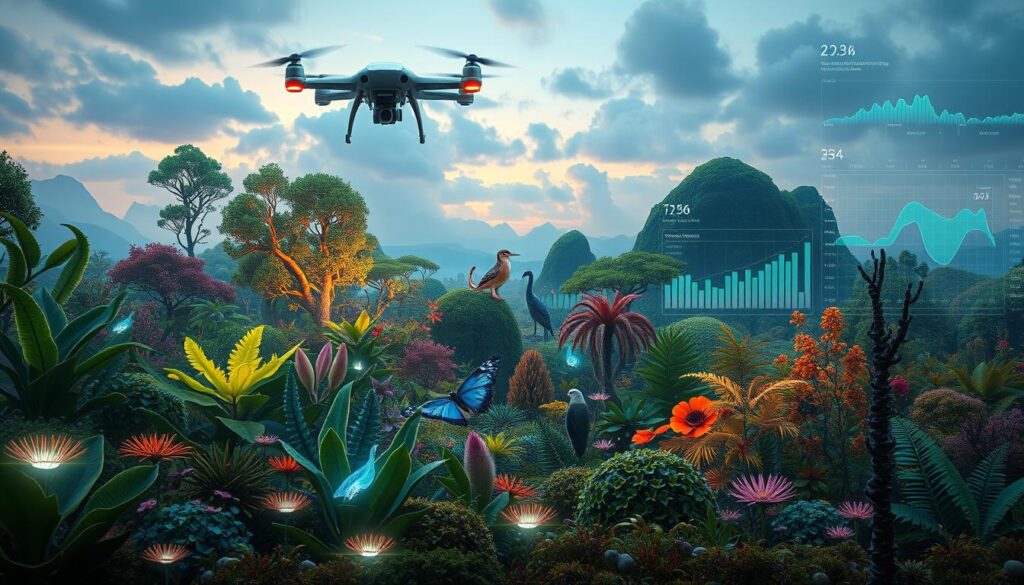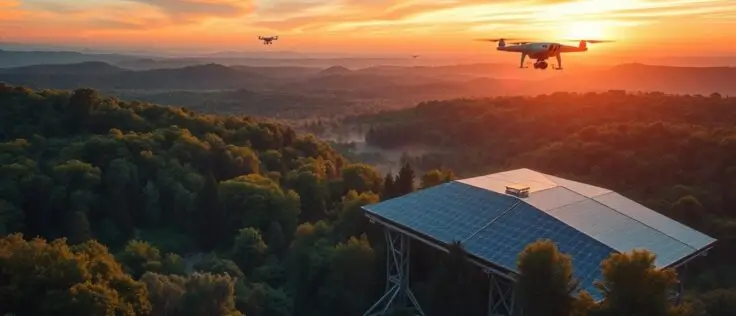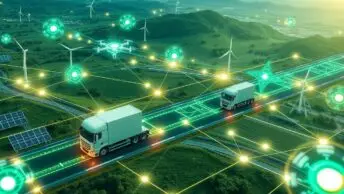Global warming poses a huge threat to our world. The use of Artificial Intelligence (AI) in fighting this has changed the game. With the UN setting up an AI Advisory Body and the approach of COP28, we’re left to wonder: can AI really help build a sustainable future?
AI isn’t just a trendy term; it shines as a beacon of hope. It improves climate models and predictive analytics. This progress supports our global goals for sustainability. It gives us tools to tackle environmental disasters and ensures everyone has access to clean energy. Despite funding drops for clean energy in poorer countries to $10.8 billion in 20211, AI stands as a key tool. It helps shift these countries toward greener solutions.
The fast-growing fashion sector brings economic gains but also harms the environment. It employs around 300 million people worldwide and has a huge carbon footprint1. AI promises to make supply chains efficient, cut waste, and foster eco-friendly manufacturing. This respects both people and our planet1.
In the fast food world, responsible for 22% of global greenhouse gas emissions1, AI plays a crucial role. AI-driven smart grids boost the industry’s energy efficiency. They show how AI can transform different industries. Smart meters track energy use. They gather lots of data that help make energy use smarter2.
AI also uplifts agriculture, making our food systems resistant to climate change1. With AI, farmers use resources smartly to increase food production. This approach protects natural resources too.
As the climate crisis worsens, AI’s role in predicting climate changes and offering green solutions becomes more critical. AI’s help in fighting environmental threats highlights our creativity. It shows how we use technology to protect Earth.
The Current Role of AI in Tackling Global Warming
Artificial Intelligence (AI) is changing the game in fighting global warming. It’s making environmental monitoring more accurate and improving how we track emissions. This step forwards is crucial for battling climate change well.
Enhanced Prediction and Climate Modeling
AI uses smart algorithms to decode complex weather patterns. This leads to better forecasts and understanding of climate changes. It allows us to act early against potential climate threats. The mix of satellite and ground observations with AI brings a detailed picture of environmental shifts. This empowers decision-makers to take well-informed steps towards climate action4.
Resource Management and Energy Efficiency
AI changes how we manage resources by making energy use smarter and cutting waste. Google has already cut energy for cooling in their data centres by 40% using AI3. It’s also improving energy efficiency in many sectors, helping operations run smoother and keeping infrastructure in top shape.
AI-Driven Conservation Efforts
AI’s role extends to preserving nature. It helps monitor ecosystems in real-time and protect biodiversity. By spotting patterns of harm early, it guides us to act efficiently. AI tools support efforts in forest and wildlife conservation, too. They help keep an eye on habitat health and track how species are doing.
Empowering Renewable Energy with Artificial Intelligence
Artificial Intelligence (AI) is changing the renewable energy world, helping reduce carbon emissions and promote green solutions. It boosts efficiency in making energy and uses resources well to grow the use of Renewable Energy.
Optimising Energy Grids
AI changes how we create, share, and use power. It improves how electricity is given to places when they need it the most. This avoids power cuts and keeps energy flow steady from green sources5.
Machine learning also predicts when gear might break or need fixing. This lowers the chance of unplanned stops and improves grid work5.
Predictive Maintenance in Renewable Energy
AI focuses on Predictive Maintenance to lower gear failure risks. This is key for keeping power generation constant, especially in hard-to-reach solar and wind farms5. AI in predictive analytics spots maintenance needs early, cutting operation costs and boosting output.
AI for Sustainable Solutions in Energy Production
AI does more than make operations better; it helps create better green energy. Groups like Sustainable Energy for All work with countries to make energy plans with AI. This makes renewable energy better suited to each place’s needs6.
In Rwanda, AI financing models help more people get energy. This shows AI’s vital role in reaching good, affordable renewable energy solutions6.
With AI, reducing the world’s carbon footprint and increasing green energy is more achievable. As tech grows, AI’s influence in renewable energy expands. This is a key move towards global sustainable energy.
Understanding and Combatting Climate Change with Data Analysis
Data Analysis plays a crucial role in taking effective Climate Action. Nowadays, AI for the Environment turns large datasets into useful insights, aiding climate efforts. It’s great at handling heaps of data fast. This is key for creating computer models that show different climate outcomes. These models are vital for they let researchers and those making policies come up with informed strategies.
Also, AI is amazing at spotting patterns and learning from them. It uses machine learning to make supply chains in many sectors more efficient, which helps cut down on carbon emissions by making supply and demand predictions better7. This step is important for developing sustainable methods that match our climate objectives. Moreover, predictive models by AI increase our grasp on possible weather effects, preparing us better and keeping our infrastructures safe from climate-caused incidents8.
Backing these efforts means welcoming AI technology is key. As AI gets better, its uses in climate modelling, disaster readiness, and managing resources prove vital in encouraging eco-friendly solutions. The advanced data analysis offered by AI not only improves climate models but also backs worldwide actions in lowering greenhouse gases and promoting health for both people and the planet.
Emission Tracking and Reductions Aided by AI
AI is revolutionising how we track emissions and find sustainable solutions.Over 70% of the world’s economy is aiming for zero net emissions by 20509.AI helps keep Earth’s temperature from rising above 1.5°C by improving fuel usage and cutting commute times. These advances shrink our carbon footprint significantly9.
Digital tech, powered by AI, could reduce global CO2 emissions by 20% by 2030. This is a big step towards the goals of groups like Digital Europe9. In transportation, AI enables better route planning and fleet management. This sector contributes about 25% to global emissions, so AI’s impact is crucial for sustainability9.
On the business front, AI can cut emissions by up to 10% and reduce energy costs by 10-20%. This promotes green practices that also save money9. AI leads to predictive maintenance, cutting downtime by 30% and speeding up repairs by 83%. It reduces on-site engineer time by up to 75%, helping to cut emissions and foster sustainable production9.
AI is reshaping supply chain management, expected to be worth $17.5 billion by 2028. It creates efficient, clear, and green supply chains that adapt quickly to market changes9.
AI also promises to lower greenhouse gas emissions by up to 34% by 2050, especially in autonomous vehicles. It optimises routes, speed, and battery use in systems like Tesla’s Autopilot, showing the vast potential of smart technologies for the environment9.
AI improves parking efficiency by predicting demand with 75% more accuracy. These refined AI uses can have wide environmental benefits, thanks to smart tech applications9. As such, AI is crucial in emission tracking and promoting sustainable solutions. It’s key to global carbon footprint reduction efforts and changing how industries operate for the better.
Adaptive AI for Environment Protection
Artificial Intelligence (AI) is changing how we protect our environment. It helps globally with pollution control, conservation, and sustainable farming. AI addresses serious environmental issues.
Monitoring Biodiversity Through AI
AI improves our ability to monitor and safeguard biodiversity very precisely. Technologies like machine learning and satellite images track deforestation and wildlife. These tools help conservationists predict and tackle threats to our ecosystems. This is key to keeping our planet’s biodiversity.

Implementing Sustainable Practices in Agriculture
In farming, AI encourages sustainable methods that lessen environmental damage. It lets farmers increase crop yields with less chemicals. This lowers farming’s environmental impact. Adopting AI in farming helps fulfil sustainable agriculture goals and supports the FAO’s climate-resilient strategies. This aims to enhance productivity while conserving natural resources10.
AI-Assisted Pollution Control Measures
AI plays a big role in fighting pollution. It allows for the real-time tracking and studying of environmental data. This helps manage air and water quality better. AI tools, like predictive analytics, find pollution sources and recommend fixes. AI-driven pollution control means fewer illnesses and deaths from pollution11.
Using AI in environmental protection highlights its vast potential. It makes conservation more effective, farming more sustainable, and pollution control more efficient. AI leads us to a healthier and more sustainable future for everyone.
Transforming Climate Policies with AI Insights
The use of Artificial Intelligence (AI) in shaping climate policies is a notable advance. It’s reshaping how we manage the environment and push for sustainability. Through predictive analysis and monitoring, AI paves the way for informed and flexible decisions.
Supporting Legislation with Environmental Monitoring
AI-driven monitoring is a game-changer for law-making bodies. They can now rely on it for accurate, real-time environmental data. This info covers air quality, water levels, and forest growth, leading to proactive rule-making.
Informing Conservation Policies via Predictive Analysis
Facilitating International Cooperation on Environmental Issues
AI is key in bringing countries together over climate issues. It improves sharing and understanding data worldwide, setting the stage for global agreements. This support helps world leaders make joint, firm steps for a green future12.
AI and Climate Change: Mitigation Strategies and Opportunities
As we face increasing climate change challenges, Artificial Intelligence (AI) plays a crucial role. It brings advanced solutions, helping various sectors aim for zero carbon emissions.
AI in Mitigating the Carbon Footprint of Industries
AI is transforming the industrial sector by boosting energy use and cutting down greenhouse gases. Especially in areas like manufacturing and farming, its impact is groundbreaking. AI predicts and manages energy needs, making industries less harmful to the environment.DeepMind’s work in boosting wind energy production by 20% shows AI’s potential in making industries more sustainable15.
Climate Resilience through AI-Powered Innovations
AI-powered tools are making societies more resilient to climate change. They improve predictions in weather and disaster planning. This helps in building stronger infrastructures ready for climate ups and downs16. Google’s Flood Hub, for example, has sent vital flood warnings to millions. It plays a key part in making communities ready for natural threats15.
Integrating AI into Climate Action Plans
Today’s climate action strategies are embracing AI for smarter, data-led choices. AI helps in making precise climate models and detailed plans. It adds depth to climate efforts and tailors solutions to specific environmental needs17.
Bringing AI into climate strategies improves their success, ensuring smart use of resources for the best sustainability results. AI at the heart of climate plans shows a clear, achievable route to zero emissions17.
AI-Enabled Disaster Preparedness and Response
AI helps us get ready for disasters in new, powerful ways. It predicts and lessens the dangers of storms and natural disasters. With AI, people worldwide can react better and faster when emergencies happen. This saves lives and protects buildings and roads.
Early Warning Systems and Risk Assessments
AI has made warning systems for disasters a lot better. For example, AI models predict earthquakes by looking at how the ground shifts. This helps warn people earlier18. AI also makes hurricane forecasts more precise. This means places hit by storms can get ready sooner18. And AI is great at finding where floods might happen by using images from space. This lets us know which areas could get flooded18.
AI for Rapid Response Coordination
AI is crucial in organizing fast actions when disasters strike. Like FloodNet, some AI tools predict how bad a flood will be. This helps make quick, smart choices during such times19. AI also improves training in disaster medicine. It keeps response teams up-to-date on how to manage emergencies well18.
Enhanced Disaster Management Using Predictive AI
Predictive AI is key to making disaster management better. The Climate Informatics Toolbox uses AI to look at climate data. This predicts future weather, so planners can get ready for bad weather19. In East Africa, a project works with weather offices. They use AI to give better forecasts, helping deal with climate change impacts20. This shows how AI can predict and manage disaster effects regionally.
Using Predictive AI more and more makes us ready today and in the future. It sets standards for how we can respond to disasters. This means our communities will be safer, faster at responding, and tougher.
Sustainable Urban Development with AI
Artificial Intelligence (AI) is changing urban living for the better. It’s crucial for creating Smart Cities that are sustainable. This tech doesn’t just improve efficiency; it makes city life better for everyone. AI touches everything from managing roads to checking the environment, laying the groundwork for cities of the future.
Smart Cities Enabled by Artificial Intelligence
AI innovations drive Smart Cities forward, making them sustainable. They manage resources better, like energy and traffic, and improve emergency services. This makes living in cities easier and solves usual urban problems. AI processes data in real-time, helping cities quickly adapt to needs21.
AI also predicts and manages climate changes, like extreme weather or rising sea levels21. Its advanced predictions help planners and policymakers prepare better for future events.
AI in Waste Management and Reduction
In waste management, AI boosts efficiency and sustainability in cities. It enhances how we collect and recycle waste. This not only saves money but also reduces environmental harm. AI helps in planning urban development with less environmental impact and better resource use22.
Improving Air Quality through AI Innovations
AI plays a key role in bettering air quality in cities. It does this by being part of systems that monitor pollution. For example, AI predicts where pollution might be worse and manages traffic to lower it. This proactive work is key to keeping city air clean and supports Sustainable Development Goals22.
AI’s uses in creating sustainable urban areas are growing. It opens new ways to make cities more livable and resilient. With AI, the dream of truly smart, sustainable cities is getting closer. For more on how AI can boost marketing and development, check out this detailed analysis.
Conclusion
The rise of AI and Climate Change calls for a swift shift towards Sustainable Practices and Data-Driven Solutions. Across various fields, such as renewable energy and farming, AI and environmental care together are making big changes. They aim for a lasting, healthy planet. AI plays a huge part in this; it helps us understand weather patterns better, use energy more wisely, and build strong infrastructures.
Yet, we must see AI as a double-edged sword. While AI helps fight climate change, it also depends a lot on the ICT sector. This sector’s carbon emissions might increase to 3-3.6% by 2020, with data centres being the biggest issue at 45%23. Big tech companies are trying to lessen their carbon footprint and aim for zero carbon, but being fully open about it is hard23. Also, projects like the ASG at The Alan Turing Institute show how different areas of study can use AI to tackle climate change. They also look into the UK’s recent extreme weather24.
It’s important to find the right balance between new tech and caring for the environment. AI, especially deep learning, can help predict and monitor the environment better24. AI has the power to support smarter, more efficient climate actions. Yet, it’s up to us to guide AI use wisely. We must ensure AI builds a durable, environment-friendly system. For more on AI’s role in setting prices in retail, check out how it’s being used in the, showing the wider impact and perks of smart, green tech use.
FAQ
How is Artificial Intelligence being used to fight climate change?
Artificial Intelligence (AI) is changing how we fight climate change. It helps in making powerful climate models and creating sustainable solutions. AI also opens new ways for protecting the environment, by allowing us to analyze data precisely. This leads to smarter decisions and more energy-efficient practices.
What advancements has AI brought to climate prediction and modeling?
AI has made climate predictions and models much more accurate. It can process huge amounts of data about the climate. This means we can create detailed simulations. Policymakers and researchers use these to understand and get ready for future climate scenarios.
How does AI contribute to more effective resource management?
AI improves the way we manage resources, making sure we use and distribute them better. This aids in saving energy and devising systems that monitor how we use resources. This approach reduces waste and leads us towards a more sustainable future.
In what ways are conservation efforts being supported by AI?
AI helps conservation in many ways, like monitoring ecosystems and wildlife in real time and fighting against poaching. It assesses how healthy different habitats are. It also predicts how human actions affect wildlife. This assistance is crucial for protecting our planet.
Can AI empower the use of renewable energy?
Definitely, AI boosts our use of renewable energy. It makes energy grids work better with renewable sources. AI also helps in keeping energy production running smoothly through predictive maintenance. Plus, it makes clean energy technologies work more efficiently.
What role does AI play in emission tracking and reductions?
AI is vital in tracking emissions and finding ways to reduce them. It looks at data to make industrial processes cleaner, which cuts down the carbon footprint. AI aids in setting up sustainable practices across different sectors. It also helps in reducing waste.
How is AI used in the protection of the environment?
AI is a key tool in environmental protection. It monitors wildlife, makes farming more eco-friendly, and controls pollution. AI supports creating food systems that can cope with climate changes. It also helps in assessing the environment in real time.
How does AI aid in shaping climate policies?
AI is helpful in shaping climate policies by improving how we monitor the environment and predict future conditions. It makes international cooperation easier, providing accurate data for policy-making. This ensures that policies are informed and effective.
What mitigation strategies and opportunities does AI present to combat climate change?
AI provides strategies to fight climate change, like making industries less polluting by using energy more efficiently. It supports renewable energy innovations. AI also helps in making climate action plans more focused and successful.
How does AI enhance disaster preparedness and response?
AI boosts disaster preparedness by making early warning systems better and assessing risks in detail. When disasters happen, AI helps in coordinating a quick response. It uses its predictive powers to handle disasters better and lessen their effects.
In what ways does AI contribute to sustainable urban development?
AI makes cities more sustainable by improving how traffic flows, managing waste effectively, and keeping the air clean. It is also useful in planning cities, offering insights from data. This helps make life in urban areas better while caring for the environment.
Source Links
- Explainer: How AI helps combat climate change – https://news.un.org/en/story/2023/11/1143187
- ESG Economist – What can AI do to fight climate change? – https://www.abnamro.com/research/en/our-research/esg-economist-what-can-ai-do-to-fight-climate-change
- How can artificial intelligence help tackle climate change? – https://greenly.earth/en-gb/blog/ecology-news/how-can-artificial-intelligence-help-tackle-climate-change
- How AI can help combat climate change – https://hub.jhu.edu/2023/03/07/artificial-intelligence-combat-climate-change/
- Top 10 applications of AI in the energy sector | FDM Group – https://www.fdmgroup.com/news-insights/ai-in-energy-sector/
- AI-powered pathways: Advancing SDG7 for a sustainable energy future – https://sustainability.google/operating-sustainably/stories/ai-powered-pathways/
- How AI and Big Data can help reduce the impact of climate change | Earthly Blog – https://earthly.org/how-ai-and-big-data-can-help-reduce-the-impact-of-climate-change
- Council Post: Taking An AI Approach To Combating Climate Change – https://www.forbes.com/councils/forbestechcouncil/2024/07/19/taking-an-ai-approach-to-combating-climate-change/
- How Artificial Intelligence (AI) is driving decarbonisation – https://www.equans.com/news/how-artificial-intelligence-is-driving-decarbonisation
- AI & Sustainability: Artificial Intelligence for Tackling Environmental Challenges | FDM Group – https://www.fdmgroup.com/news-insights/ai-and-sustainability/
- How artificial intelligence is helping tackle environmental challenges – https://www.unep.org/news-and-stories/story/how-artificial-intelligence-helping-tackle-environmental-challenges
- 5 Insights into AI as a Double-Edged Sword in Climate Action – https://unu.edu/ehs/series/5-insights-ai-double-edged-sword-climate-action
- Greening AI: A Policy Agenda for the Artificial Intelligence and Energy Revolutions – https://institute.global/insights/climate-and-energy/greening-ai-a-policy-agenda-for-the-artificial-intelligence-and-energy-revolutions
- AI and Climate Change: Leveraging Technology for Environmental Sustainability in 2024 – https://www.linkedin.com/pulse/ai-climate-change-leveraging-technology-environmental-dave-balroop-amqrc
- What opportunities and risks does AI present for climate action? – Grantham Research Institute on climate change and the environment – https://www.lse.ac.uk/granthaminstitute/explainers/what-opportunities-and-risks-does-ai-present-for-climate-action/
- AI Technology is Revolutionizing Climate Change Mitigation | Appen – https://www.appen.com/blog/how-ai-technology-is-revolutionizing-climate-change-mitigation
- PDF – https://us.boell.org/sites/default/files/2020-12/Artificial Intelligence and Climate Change_FINAL.pdf
- Potential Use of Artificial Intelligence (AI) in Disaster Risk and Emergency Health Management: A Critical Appraisal on Environmental Health – https://www.ncbi.nlm.nih.gov/pmc/articles/PMC10712270/
- AI-enabled strategies for climate change adaptation: protecting communities, infrastructure, and businesses from the impacts of climate change – Computational Urban Science – https://link.springer.com/article/10.1007/s43762-023-00100-2
- AI-led science innovation protects communities hit by climate change – https://www.ox.ac.uk/news/2024-06-25-ai-led-science-innovation-protects-communities-hit-climate-change
- Assessing the Potential of AI–ML in Urban Climate Change Adaptation and Sustainable Development – https://www.mdpi.com/2071-1050/15/23/16461
- AI-Driven Sustainable Cities: Pioneering Urban Innovation for a Greener Tomorrow (Part 1) – https://www.linkedin.com/pulse/ai-driven-sustainable-cities-pioneering-urban-greener-atuesta-ruiz-sjgoc
- Artificial intelligence and climate change: ethical issues – https://www.emerald.com/insight/content/doi/10.1108/JICES-11-2021-0106/full/html
- PDF – https://www.turing.ac.uk/sites/default/files/2023-03/turing_asg_whitepaper_climatechange_0.pdf






